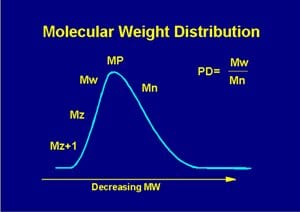Some of the high-efficiency polymers for organic photovoltaic applications (power conversion efficiency > 10%) are now commercially available in small quantities for laboratory-scale research and development. Quite often, these polymers are dispatched to the end-users, where batch-to-batch variations may occur, and lead to large fluctuations in device performance. Clearly, the batch-to-batch variation is a key obstacle for the commercialization of the specific technology in the future and needs to be better controlled. The variation in performance is mainly attributed to the molecular weight of the polymers. Particularly, important aspects in a variety of polymers are th e correlation between the number-average molecular weight (Mn) and polydispersity index (Đ) of the polymer and its solar cell performance.
e correlation between the number-average molecular weight (Mn) and polydispersity index (Đ) of the polymer and its solar cell performance.
In a recent review article researchers from Ioannina (Greece) and Erlangen (Germany) present a systematic analysis of the influence of Mn and Đ in newly developed electron donor conjugated polymers for high performance organic photovoltaics bringing together many studies published in the literature. It becomes evident that there is a tradeoff between the increment of Mn and the processability of the resulting polymeric ink. As the molecular weight of the polymer increases up to the point where the polymer exhibits good solubility in the organic solvent, hence enabling the easy processing, the charge transporting properties and the absorption coefficient of the pristine polymeric films increase.
This review not only discusses approaches to follow in order to enhance the molecular weight of electron donor polymers (e.g. by changing the catalyst or considering the exact stoichiometric composition of very clean precursors) but also how this influences the optoelectronic properties, charge transport properties, structural conformation, morphology, and the photovoltaic performance of the active layer. These trends should be of interest for everyone working in the field of organic photovoltaics.

















